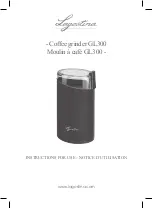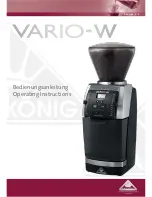
13
English
Espresso Brewing Technique
Brewing Temperature
Water temperature and temperature consistency have a
direct impact on the flavor of espresso. Great espresso
comes from brewing at an optimum temperature, ideally
between 90º–96º C. Modern boilers and thermostats excel
at producing and maintaining the right temperature, but
there is a complicating factor that is a major concern for
baristas: maintaining heat in the brew group.
If water is pumped from the boiler at a near perfect
93º C, but flows into a filter holder that’s at room
temperature, the water will cool dramatically – and the
actual brewing temperature will be far less than what the
best espresso requires. If the water temperature drops
below 90º C, the espresso might still exhibit good crema,
but it will acquire a distinctly bitter or sour note.
To Insure Proper Brewing Temperature:
• Always attach the filter holder (with filter basket) to the
brew head when the espresso machine is heating. This
warms the filter.
• Always wait until the boilers are fully heated before
brewing – at least 6 minutes.
• Dose and tamp your coffee quickly, and brew
immediately. This prevents the filter holder from cooling
significantly.
• Never rinse the filter holder with cool water if you are
brewing additional cups. After knocking the old grounds
from the filter, wipe leftover grounds from the basket
with a clean towel. Make sure the filter basket is dry
before adding more coffee.
• Keep the empty filter holder attached to the brew
head when you’re engaged in other tasks, like
grinding or frothing.
• Warm a cup or demitasse by placing it on top of the
espresso machine before brewing. Cups can also be
heated instantly with steam from the frothing arm.
The Artisan™ Espresso Machine is designed to provide
an optimum brewing temperature. Dedicated dual boilers
eliminate the temperature fluctuations common with
single boiler designs when alternating between brewing
and frothing. The chrome-plated brass brew group heats
quickly, and is commercial-size for a very good reason:
commercial-size groups retain heat better than
smaller groups.
The Espresso Machine does it’s part to provide the
right brewing temperature. The rest is up to the barista!
Grinding
Great espresso demands the freshest coffee, and the
freshest coffee is always ground immediately before
brewing. The most delicate aromatic compounds in coffee
go stale within a few minutes of grinding, so grind only as
much as you intend to brew immediately.
Dosing
Dosing is the process of measuring ground coffee into the
filter basket. A single cup (30 ml) of espresso requires
7 grams of coffee – two cups, twice that. If filled level
with finely ground coffee, the scoop included with the
Artisan™ Espresso Machine is a near perfect measure for
one cup of espresso.
Accomplished baristas usually don’t bother making
precise measurements when dosing: they simply fill the
basket nearly to the brim and sweep any excess coffee from
the filter with their fingers, leaving exactly what they need.
After you’ve had some experience dosing, leveling, and
tamping your coffee, you’ll be able to consistently dose
your coffee by sight, just like the pros.
If you’re dosing coffee without the aid of a measuring
scoop, it is important not to overfill the filter basket. Coffee
needs room to expand when brewing. If the coffee is
crushed against the shower screen, it will prevent an even
dispersion of water across the filter, leading to uneven
extraction and poor espresso. Here’s how to tell if you’re
overfilling the filter basket:
1. Fill the basket, level the coffee, and apply a good tamp
(see the section, “Tamping”).
2. Attach the filter holder to the brew head, then remove
it immediately.
3. If the coffee in the filter holder has an imprint of the
shower screen or the shower screen screw, there is too
much coffee in the filter basket!
Leveling
Leveling the coffee after it has been dosed into the filter is
a critical technique for great espresso. If the coffee isn’t
evenly distributed in the filter, tamping the coffee will
create areas of high and low density. The high pressure
brew water will inevitably follow the path of least
resistance, flowing heavily through the low density coffee
– overextracting the bitter coffee compounds – and
flowing lightly through the higher density coffee,
underextracting the flavorful essences. This uneven
extraction results in thin, weak, bitter espresso.
To Level Coffee In the
Filter Basket:
• Make sure the filter basket is dry before adding coffee;
moisture in the basket will create a path of least resistance
for the brew water.
• After dosing the filter with coffee, level the coffee by
sweeping a finger back and forth over the filter. Do not
sweep in one direction only – this will cause the coffee to
pile up on one side of the basket and produce uneven
extraction. Try to impart a slight bowl shape to the
coffee, with the center lower than the sides.
• Make certain there are no gaps between the coffee and
the sides of the filter.
Properly Leveled Coffee
















































